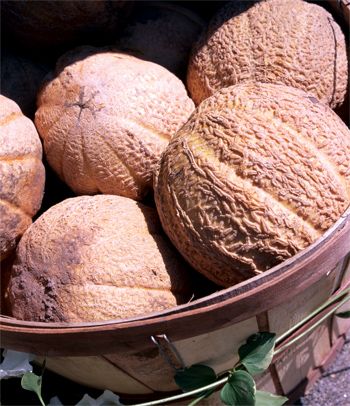Guide to Growing Cantaloupe – Muskmelon Growing Basics
This is Gertens’ guide to growing cantaloupe, where you can learn muskmelon growing basics. Muskmelon, also known as cantaloupe, is a tender, heat-loving vegetable. Most varieties of the muskmelon have a musk smell; thus the name muskmelon. Muskmelons originated in India and were cultivated by settlers in the 1600's.
When to Plant

Muskmelons may be directly seeded or started as transplants. If the weather and soil are not warm and the soil moisture level is moderate, the seeds do not germinate and the plants do not grow. Plant after the danger of frost has passed and the soil has warmed and dried. Gardeners in northern climates or other short-season areas who want early production may need to use transplants. To increase earliness, start seed for transplants 3 to 4 weeks before planting time. Because muskmelons do not transplant well if the roots are disturbed, you should start seed in individual containers. Proper temperatures for germinating and growing the transplants are very important. Do not allow transplants to become too large before planting in the garden or stunting and crop delays may result. Sterilized media should be used for starting seed to prevent damping-off and other diseases of seeds and seedlings.
Spacing & Depth
Plant seeds one inch deep and thin the seedlings 18 to 24 inches apart or the equivalent (two plants every 36 inches or three plants every 48 inches in the hill system). Space rows at least 5 feet apart.
Care
Fertile soils usually grow a fine crop of muskmelons with normal fertilizer application such as Gertens All Purpose Plant Food or Garden-Tone when the plants begin to vine. Muskmelons benefit especially from the incorporation of well-rotted manure before planting and also appreciate high potassium. All melons respond favorably to mulching with black plastic, especially early in the season. The mulch can be installed when the soil is in good planting condition anytime from a few days to 2 or 3 weeks before planting. Make holes every 2 or 3 feet to plant seed or transplants through the plastic. Use starter fertilizer to help transplants get established. Floating row covers also can be used to advantage over early season melon transplants. These covers exclude the worst of the cold and also early season insect invaders. Covers need not be removed until plants start to flower unless extremely hot weather threatens.
Muskmelons suffer from extremes in soil moisture (too much rain or an extended drought). Irrigation is recommended in case of drought, especially when the vines are growing and the fruits are developing. Trickle irrigation systems used with black plastic mulch work extremely well. Muskmelons ripen to the highest quality when the vines remain healthy throughout the harvest period, when temperatures are warm but not excessively high and when the weather is comparatively dry at the time of maturity.
Harvesting
Good eating quality depends upon the texture of the melons and the development of sugars from proper ripening on the vines. When muskmelons are ripe, the rind changes from a green to tan or yellow between the netting. They should be picked when the stem separates easily from the vine near the point of attachment ("half-slip" or "full-slip" stages of development). At these stages, there will be a crack near the point of attachment. Do not pick too early because the quality will not be as high as that of vine-ripened melons; sugars continue to be stored in the developing melons up to the moment the stem separates. Once picked, muskmelons soften but do not sweeten further.
Harvest early in the day after the plants are dry and be careful not to damage the vines. Pick every other day at the beginning of the season and go over the patch every day at peak season. Especially in dry seasons, wildlife and insects such as picnic beetles quickly attack the sweet, juicy, ripening and softening fruit.
Common Problems
Control cucumber beetles with an organic pesticide like Captain Jack's Deadbug Brew. They damage muskmelons and spread bacterial wilt by feeding on the plants.
